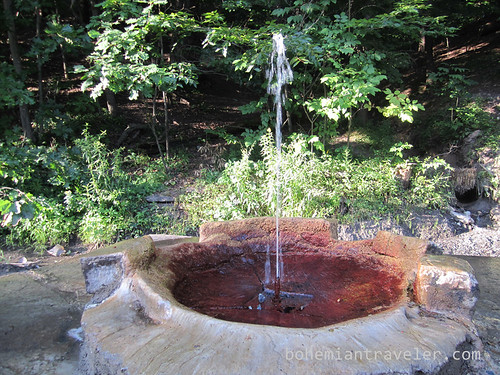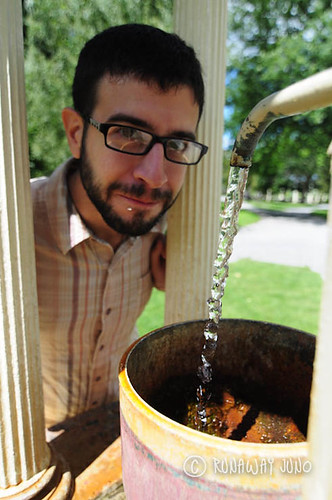
Today, Saratoga Springs, New York is known as a summer getaway, famous for its horseracing culture. The track opened on August 3, 1863, and is the oldest organized sporting venue of any kind in the United States. For six weeks every summer, the intensity of the horse racing lasts from dawn until dusk daily. For the other 10 ½ months, Saratoga Springs is a town celebrated for its arts scene, romantic architecture, and sophisticated shops and restaurants. But there is something else which makes Saratoga unique among resort towns, something which preceded all of the above.
Saratoga Springs recognized its wealth of mineral waters and developed as a spa in the 19th century. At one point its Grand Union Hotel was the largest hotel anywhere in the world.
What’s remarkable is the fact that while many of the springs are located in Saratoga Spa State Park outside of town, some of the others are right in the downtown in Congress Park.
Saratoga retains an obvious air of bourgeois, somehow seeming to suppress any appearance of alternative, hippy or bohemian lifestyles that would almost certainly be present if Saratoga was located in, say, Colorado or New Mexico. While visiting the springs in the state park, we met one of the most eccentric men at the mineral waters. He was a Vermonter and spoke to us for almost 30 minutes, before retiring to his RV, explaining the medicinal properties of each of the springs and how some had changed, and even saved his life.
The mineral springs are thought to have been discovered by the Mohawk in the 14th century. They even brought Sir William Johnson to what they called, “Medicine Spring of the Great Spirit”. Others recognized the medicinal and commercial benefits of the springs and by the early 1900’s some springs were dry due to excessive commercial pumping. In 1909, the state of New York established a reserve to protect the largest cluster of springs. This would develop into the Saratoga Spa Park, where a hotel and two magnificent bath houses were later built.
Most of the springs surface in Congress Park, High Rock Park, and Saratoga Spa Park. Each is marked by a pavilion or fountain. The mineral content, and therefore taste, of each spring differ. Many are reputed to have a medicinal or therapeutic value as well. The spring water is free, so bring your water bottles and fill up!
Congress Park
- Congress Spring—Discovered in 1792, waters from Congress Spring were bottled and sold throughout Europe and the United States. The spring is covered by a Greek Revival pavilion, similar to the one built in 1826.
- Deer Park Spring—This diminutive cast iron fountain, built around 1880 dispenses a derivative of Congress Spring Water.
- Hawthorn #1—Located on the corner of Putnam and Spring Street, Hawthorn #1 is a highly mineralized, diuretic water.
High Rock Park
- Peerless Spring—A palatable saline water of moderate strength.
- High Rock Spring—The Mohawk carried the ailing Sir William Johnson here where he was healed. Following this, he spread the word about the health benefits of Saratoga’s Springs.
- Old Red Spring—Known as the “beauty spring”, Old Red is famous for healing skin disorders.
Saratoga Spa State Park
- State Seal—Delicious, fresh water.
- Polaris Spring—The effects of drinking the minute quantities of radon gas present in this pleasant tasting water is debated among health professionals.
- Hayes Well Spring—With a strong taste and smell, some believe inhaling the spring’s carbon dioxide gas at the back of the fountain pedestal will clear the sinuses. Drinking it will act as a laxative.
- Hawthorn #3—Once extremely popular, this spring’s waters are slightly cathartic. It is highly mineralized and the saltiest of Saratoga’s springs.



Who is the Hayes who founded the Hayes Well Spring?
Very well, I shall tell you. My great-grandfather, Thomas B. Hayes (1858-1924), was the owner of the property around Hayes Well Spring, known as “The Geysers,” that now makes up a section of Saratoga Spa State Park. NYS acquired the land by 1917 through exercise of eminent domain, with nominal payment to the Hayes family. The Hayes family lived in and around Saratoga Springs through much of the 19th and 20th centuries. Thomas’s younger brother Dennis had a business and home at 25 Church Street in SS (now the Country Corner Café), in the late 1800s and early 1900s. Thomas ran spring-water and carbonic-gas wells for most of his active life.
Thomas Hayes’s father-in-law, James Geary, died in in Saratoga Springs in August 1863 from three wounds received at the Second Battle of Bull Run a year before. Geary lived that long thanks to the skill of the family physician, the village’s famous water-cure practitioner Norman Bedortha, who had a medical practice across Broadway from Congress Park.
I spent the earliest years of my childhood growing up in Saratoga Springs as my late father was an organic chemistry professor at Skidmore College and my late mother a nurse who sometimes worked at Saratoga Springs Hospital or Glens Falls Hospital. Our family lived a 9 Jefferson Street before we relocated in 1963 to Madison, Wisconsin. I drank spring water so many times at my favorite place in the world, Congress Park! I simply loved the fresh mineral tatse have have been back most recently about 9 years ago and had to savior the mineral water once again. Can’t wait to my next visit! You have a great thing going Saratoga, and a strong piece of my heart will always belong to you!
Visited the Hawthorn#1 spring this summer and drinked from its fountain; the taste was quite peculiar! I poured some of this mineral water into a plastic water bottle and brang it back home to Canada. I took me almost a month to finish it, but what I saw in the bottom of the bottle was astonishing and somewhat alarming: the bottle had started to melt, it was affected with tons of micro-bubbles in the bottom; sort of as if the water had burned it slowly! I still have the bottle with me, and I’ve decided to post tjis information freely for all to read. It’s truly alarming, especially because of the fact that I was going to Saratoga Springs to actually seek the health benefits of its mineral waters. I think I found something to worry about! Did anyone else have the same outcome ?
The only mineral water from the State Park that should be put in a plastic bottle is one called “State Seal” which is located across the street from the National Auto Museum. All the rest of the mineral water should be put in a glass bottle as the minerals in Hawthorn #1 and Hawthorn #3 have a high mineral content. I was born and raised in the Saratoga area and have been drinking the spring water for most of my life. Each one of the mineral springs has a different medicinal history which can be found at (http://saratogaspringsvisitorcenter.com/wordpress/wp-content/uploads/2011/07/BROCHURE-Mineral-Waters.pdf). I know from experience when obtaining and drinking Hawthorn #3 you can see a mineral build up the inside of the bottle when stored over a period of time. I do not know if the mineral water loses it’s stated medicinal purpose but I’ve drank it after it being stored in a refrigerator for months. Bottom line if you return and desire to take more home put it in a glass bottle.